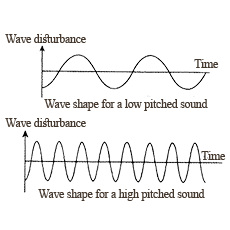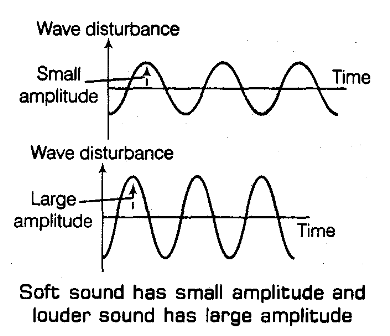Characteristics Of Sound Wave

We can describe a sound wave by its
- frequency
- amplitude and
- speed
A sound wave in graphic form which represents how density and pressure change when the sound wave moves in the medium. The density as well as the pressure of the medium at a given time varies with distance, above and below the average value of density and pressure.

Image (a) Shows the density and image (b) shows the pressure variations as a sound wave propagates in the medium.
Compressions are the regions where particles are crowded together and represented by the upper portion of the curve in image (c).
The peak represents the region of maximum compression. Thus, compressions are regions where density as well as pressure is high. rarefactions are the regions of low pressure where particles are spread apart and are represented by the valley, that is, the lower portion of the curve in image (c). A peak is called the crest and a valley is called the trough of a wave.
The distance between two consecutive compressions (C) or two consecutive rarefactions (R) is called the wavelength. The wavelength is usually represented by λ. Its SI unit is metre (m).
We know that when sound propagated through a medium, the density of the medium oscillates between a maximum value and a minimum value. The change in density from the maximum value to the minimum value, makes one complete oscillations per unit time is the frequency of the sound wave. If we count the number of compressions or rarefactions that cross us per unit time, we will get the frequency of the sound wave. It is usually represented by v (Greek letter, nu ). Its SI unit is hertz (symbol, Hz).
The time taken by two consecutive compressions or rarefactions to cross a fixed point is called the time period of the wave. It is represented by the symbol T. Its SI unit is second (s). Frequency and time period are related as follows :
v = 1/T
Objects of different sizes and conditions vibrate at different frequencies to produce sounds of different pitch.

Fig:- Low pitch sound has low frequency and high pitch of sound has high frequency.
The magnitude of the maximum disturbance in the medium on either side of the mean value is called the amplitude of the wave. It is usually represented by the letter A. For sound its unit will be that of density or pressure.
The loudness or softness of a sound is determined basically by its amplitude. The amplitude of the sound wave depends upon the force with which an object is made to vibrate. A sound wave spreads out from out from its source. As it moves away from the source its amplitude as well as its loudness decreases . The wave shapes of a loud and a soft sound of the same frequency.

The quality or timber of sound is that characteristic which enables us to distinguish one sound from another having the same pitch and loudness. The sound which is more pleasant is said to be of a rich quality. A sound of single frequency is called a tone. The sound which is produced due to a mixture of several frequencies is called a note and is pleasant to listen to. Noise is unpleasant to the ear! Music is pleasant to hear and is of rich quality.



